Environmental Stewardship
The Huffington Post reports:
In the holiday season, many of us reflect on what it is for which we are thankful. Naturally, we give thanks when things are going well, and even in a disaster we might be grateful that the catastrophe was not worse or that people stepped forward to render assistance. Claudius's poem presupposes a general climatic stability that for several centuries has been conducive to thankful worship.
But how does this optimistic hymn play in the era of radical climate change? How will it sound in the future, when each decade may bring yet more frequent and extreme climate events? What is the providential reading of "God's almighty hand" in a prolonged and life-threatening drought, or in the agrarian disaster of a dust bowl? When we are battered by a Hurricane Sandy or Katrina, how do we understand the majestic line about God in the Navy hymn, "Who bidd'st the mighty ocean deep its own appointed limits keep?"
Read more here.

Delegates from around the world are meeting in Doha, Qatar this month to discuss United Nations’ climate policy. In the past, these meetings were a source of hope for the environmental movement, as governments came together and committed to reducing emissions to collectively try to halt climate change.
Unfortunately, that is no longer the case.
Remember the Kyoto Protocol? Even though the reductions it mandated were nowhere near what’s required for us to reverse the trend we’ve started, we haven’t even come close to achieving those reductions. Oh yeah, and the United States didn’t even sign it.
The Protocol is expiring this year, and the U.N. Framework Commission on Climate Change (the body that created the Protocol — stick with me here) is trying in Doha to extend it for a couple years until they can reach an agreement on how to move forward.
So what’s holding the discussions back?
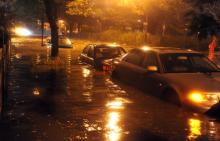
IF IT WASN'T the year from hell for the North American continent, it was the year from a place with a very similar temperature.
It's hard to remember, but it began with that bizarre summer-in-March heat wave that meteorologists described as one of the most anomalous weather events in the country's history. Before long there were record blazes burning in Colorado and New Mexico, and then a stifling heat wave moved east, triggering a "derecho" storm that raced almost 1,000 miles from Indiana to the Atlantic and left 5 million without power. July was the hottest month ever recorded in the United States; it was also when drought descended full force on the Midwest, stunting corn and soybeans and driving the world price of grain up by 40 percent (and making sure our hellish year became traumatic for poor people the planet round). By August it was clear we were in for a record melt year in the Arctic; when the long polar night finally fell, it was clear we'd essentially broken one of the planet's biggest physical features. And all that was before Sandy piled into our greatest urban area, leaving behind an indelible image of the future.
So the question becomes, what's an appropriate response? What even begins to match the magnitude of the trouble we face? What doesn't seem like spitting in the wind?
My sense is that the time has come to take on the fossil fuel industry itself—not the members of Congress they buy in droves each election season, but the real powers. Ignoring the damage they've already caused, these people spend hundreds of millions of dollars each day looking for new fossil fuels. And they spend hundreds of millions each year making sure no government stops them. They're like the tobacco industry at this point, except that instead of going after your lungs they're going after the lungs of the planet.
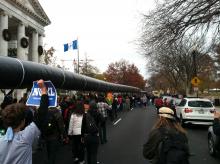
The Global North and West is addicted to fossilized fuel. Myself included. And we are trying to push our addictions onto the Global South.
Everywhere we look the fossil fuel pushers are in our face, luring us into our next fix.
Not a week after the elections, the American Petroleum Institute launched ads in Alaska, Louisiana, New Mexico, Colorado, Virginia, Arkansas, and North Carolina targeting U.S. senators who are raising the issue of climate change; specifically, the ones calling into question oil company subsidies.
The oil and gas companies try seduction ("fighting for jobs"). They try fear ("we are too big to fail"). They accuse us of being unfair to them ("Discriminatory treatment of the oil and gas industry is a bad idea"). They try bullying and slandering.
Even when our court system recently convicted one of them killing (BP convicted of "manslaughter" for the 11 murdered on Gulf Oil spill rigs), they are not stopped.
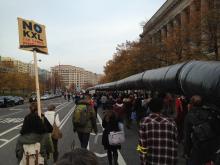
Midway through his nationwide, one-month Do The Math tour, Bill McKibben — author, environmental activist, and founder of 350.org — attracted a crowd that packed the Warner Theater in downtown Washington, D.C., on Sunday.
Joined both onstage and by video by a diverse group of speakers, including Rev. Lennox Yearwood of the Hip Hop Caucus, author Naomi Klein, and Archbishop Desmund Tutu, McKibben’s Do The Math tour brings to light the stark numbers of our current climate reality, first brought to the public’s attention in his viral article in Rolling Stone this past summer.
The three main numbers are as follows: 2 degrees Celsius is the maximum level of warming our planet can endure before real catastrophe occurs. To stay below 2 degrees C, we cannot burn more than 565 gigatons of carbon dioxide. But the problem is that the fossil fuel industry has 2,795 gigatons in their reserves — five times the safe amount to burn. As is their business plan, to reap the profit from these reserves, the fossil fuel companies plan on burning all of it, “unless we rise up to stop them” states the 350.org website.
James Balog and Jeff Orlowski, makers of the documentary film 'Chasing Ice' sit down with the "Morning Joe" MSNBC crew to discuss the implications of climate change and arctic ice melt. Check our our Sojo review of the film.
Visit NBCNews.com for breaking news, world news, and news about the economy
Mother Jones reports:
"Cap and trade" may be a dirty expression inside the DC Beltway, but as of today in California it's the law of the land. Gov. Jerry Brown has brushed aside dire warnings from the fossil fuel industry to forge ahead with the state's first-ever auction of emissions permits under its groundbreaking climate law, AB 32. This morning's auction marks the official launch of the world's second-largest carbon market.
At heart, the concept is elegantly simple. Suppose you wanted to persuade a group of 10 pack-a-day smokers to cut back, and you controlled the cigarette supply. In the beginning, you'd provide the group with 200 cigarettes (10 packs) a day, which they'd have to bid for. That's the "cap." Then, each month, you would reduce each person's daily allottment of smokes, gradually lowering the cap. The people who managed to smoke less could sell their extras to the more hard-core smokers for whatever they were willing to pay. That's the "trade" part.
Read more here.
On Saturday, Sojourners sent a group of staff members sailing down the Anacostia River.
But this was no pleasure trip.
Dottie Yunger, from the Anacostia Watershed Society, teamed up with Sojourners’ Creation Care campaign to teach some of our staff and a few other members of the local community about the state of the Anacostia river, how we as people of faith can be better stewards of our God-given resources, and how we can help create a healthier system where all creatures (both human and non-human) can survive and flourish.
Here are a few reflections from the trip.
The Guardian reports:
For Americans concerned about the environment, disaster was avoided on Tuesday. President Obama – with his somewhat lackluster record, if decidedly more exalted rhetoric, on global warming – defeated the Republican challenger who had vowed to gut federal emissions standards, and kill loan programs and tax breaks for green energy companies.
But activists say that it would be wrong to read the election as a stamp of approval for four more years of business as usual. They argue that voters have sent a clear signal that they want more aggressive action on the environment during the president's second term.
Read more here.

Photographer James Balog has a story for you, and it might be one you haven’t heard before. Starting in 2005, he and a team of adventurous photographers set out to provide visual, undeniable evidence for climate change. What they found he described as “decrepit old men falling into the earth and dying:” glaciers worldwide disappearing at record rates.
The film Chasing Ice is the story of their Extreme Ice Survey as they place time-lapse cameras on glaciers in Greenland, Iceland, Montana, and Alaska, and watch as they disappear. The public does not want statistics, they say. The public is being misled to believe that scientists do not agree on climate change. The public is losing interest but needs to pay attention.
As Balog and his team will tell you, the memory cards in their cameras contain the memories of the landscape, a “limitless universe of forms,” that will never be seen again. Man-made climate change (as documented by ice cores from the very glaciers that may not exist in a few years) is fundamentally altering our geology.

It is not surprising that our purely secular “environmental” movements have played out their ability to change society. For the changes we need to undertake are not only technological and political, but deeper and more difficult. They call on us to shape new institutions and new values.
When God’s Wind shattered Pharaoh’s power at the Red Sea, it was only the beginning of the creation of a new society. It took 40 years of struggle, of transformation and mistake, backsliding and grumbling, to ready a people that could live in a sacred relationship with each other, with the Earth, and with the Breath of Life.
So even if we were to shatter the gross and domineering political and economic power of our modern pharaohs, the giant corporations of Big Oil, Big Coal, Big Unnatural Gas that will not relent from over-burning and overpowering us, we would still need to be growing what religions claim to offer: a new vision of our lives.
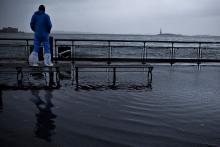
Editor's Note: Sojourners offices, which are based in Washington, D.C., will be closed due to the weather. We pray for the safety of our staff, neighbors, and all those affected by this storm.
God, we pray for all those along the East Coast in the path of Hurricane Sandy. Grant safety to all, including the first responders. We pray for all those who will lose electricity and whose homes may be been damaged. But we pray especially for those who have no homes and no shelters in times such as these. We ask that your hand would protect them and keep them safe. May our paths cross with theirs so that we might have an opportunity to love and serve them. Amen.
"O Lord of LIght" by the Innocence Mission

It was game time. The Saturday night crowd on the Vermont campus was festive, boisterous, pumped. People cheered and whooped when told that one of their heroes, climate activist Tim DeChristopher — serving a two-year federal sentence for his civil disobedience opposing new oil and gas drilling in Utah — would soon be back on the field.
When the man on the stage, 350.org’s Bill McKibben, said it was time to march not just on Washington but on the headquarters of fossil fuel companies — “it’s time to march on Dallas” — and asked those to stand who’d be willing to join in the fight, seemingly every person filling the University of Vermont’s cavernous Ira Allen Chapel, some 800 souls, rose to their feet.
McKibben and 350, the folks who brought us the Keystone XL pipeline protests, are now calling for a nationwide divestment campaign aimed at fossil fuel companies’ bottom line. Beginning with student-led campaigns on college campuses, modeled on the anti-apartheid campaigns of the 1980s, they’ll pressure institutions to withdraw all investments from big oil and coal and gas. Their larger goal is to ignite a morally charged movement to strip the industry of its legitimacy.
“The fossil fuel industry has behaved so recklessly that they should lose their social license — their veneer of respectability,” McKibben tells his audience. “You want to take away our planet and our future? We’re going to take away your money and your good name.”

Last Friday I found out I would be traveling to New York for a Climate Action Prayer Rally at the second presidential debate. I barely slept all weekend, I was so excited. I’ve never been north of Washington, D.C., before, never seen cities like Philadelphia, Baltimore, or New York. But I wasn’t just excited to see these cities, I was excited because of the reason I was going to see these cities.
I accompanied our Creation Care Campaign Director, Alycia Ashburn, and our friends from Young Evangelicals for Climate Action (YECA) to Long Island, where we would make our presence known at the debate.
Creation care is something I feel very passionately about. As a person of faith I think it is my responsibility to protect this beautiful planet that God has given us. To advocate for creation care at such an important venue is truly an honor and privilege; as I joined my brothers and sisters in sending forth a ripple of hope in the water and offering a witness that is faithful and just.

God created the earth to produce every thing Adam and then Eve — and then their issue, and then all of us — would need. In the beginning, the garden needed little tending, but — due to a rather fortunate fall — eventually Adam and Eve, as his helpmate, and their children and the issue of generations had to toil the earth to pull from the garden those things God intended to meet their needs.
Along the way, progress was made in the form of extensions of the garden bounds, the distribution of water and other nutrients, applications of healthful foods and herbs, techniques for every aspect of garden production. A community grew from a couple who worked hard as stewards, first out of penance and then, I think, out of love for the land provided to sustain them and for each other as they worked together. This is the story of how sustainability came to be.
To simplify: God created the Heavens and Earth. He designed a glorious garden and put in it everything needed to make that garden productive: plants, water, clean air, soil, enrichers (bugs, worms, life, decay), animals, and the Sun, the first and last fuel. And, finally, He made man and woman.

“Climate refugee” might be an unfamiliar term for many people, but a new film from the Catholic Coalition on Climate Change is trying to change that. Their 40-minute documentary Sun Come Up calls attention to the plight of displaced residents of the Carteret Islands, just north of Bougainville, Papua New Guinea.
Pope Benedict XVI called attention to this issue in his 2010 World Day of Peace message, saying, “Can we disregard the growing phenomenon of ‘environmental refugees,’ people who are forced by the degradation of their natural habitat to forsake it – and often their possessions as well – in order to face the dangers and uncertainties of forced displacement?”
Screenings of the film are happening across the country; groups of 50 or more can sign up to host the film and will receive a discussion guide and education kit.
Read more about the film on the Catholic Coalition for Climate Change website.

For World Food Day, here’s a roundup of recent Sojourners magazine articles about food, a subject with tendrils throughout our lives and world—from field to farmworker to plate to body!
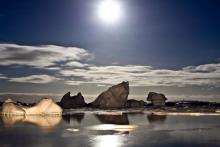
I’ll be traveling to New York tomorrow with a number of Christian colleagues. We’re having a rally — a Climate Action Prayer Rally! And you can join us!
I’m not sure about you, but I’m incredibly disappointed that our nation’s leaders – from all sectors, all parties, and all levels – continually neglect to take leadership on our climate and energy crisis.
There are many reasons that climate change should be a top election issue, but here are just a handful of the most important ones.
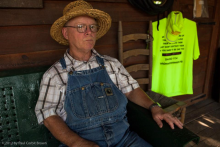
Larry Gibson, “Keeper of the Mountains,” died Sunday, Sept. 9 at his home on Kayford Mountain, W.V. He was 66. His wife and three adult children survive. Gibson had a fifth grade education, a career as a custodian at an Ohio automobile factory, and retired to the obscure and abandoned place of his birth. Gibson stood 5’2”.
“God chose the weak things of the world to shame the strong” (1 Corinthians 1:27b). From the halls of the nation’s most prestigious universities, through innumerable rallies, protests, and arrests, to the many hundreds of tours he hosted on Kayford, Gibson spoke truth to power with uncompromising integrity, unflagging determination, and heroic courage.
Larry Gibson returned to West Virginia in the 1990s, and to his shock, learned that a new method of coal extraction was literally blasting mountains apart to extract coal while shoving the vast remaining rubble into adjacent valleys burying small streams. Ecosystems were being severely, irrevocably degraded. Scarcely anyone knew about mountaintop removal back then, let alone cared.
New tracking software developed by Kevin Gurney, an ecologist at Arizona State University is intended to help cities across the country keep their word on climate. Many mayors have pledged to reduce their carbon footprint, but they have no objective way to measure progress. The software will allow them to identify and target areas of the city that are releasing the most carbon, in order to address the real problem areas.
The idea of a personal carbon footprint is not new, but software that can follow our dirty tailpipes down the street is certainly revolutionary. Could the uncomfortable feeling of being watched be the encouragement city residents need to change their habits?
"Gurney collects piles of information about a city's energy diet — from utilities, transportation departments and air-pollution monitors. When he analyzed Indianapolis, Gurney and colleagues from Purdue University and other institutions could pinpoint emissions down to the level of a building or a street."